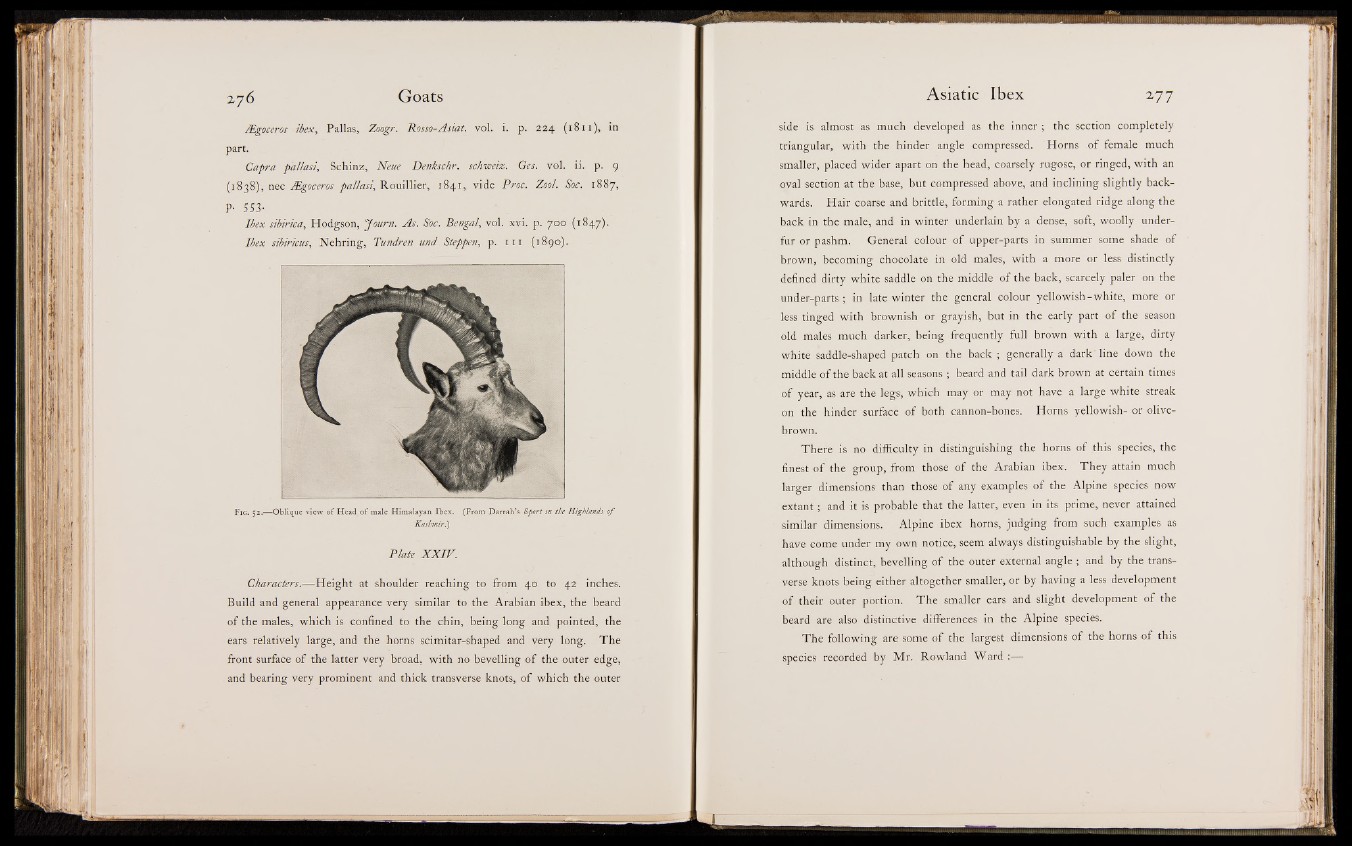
Ægoceros ibex, Pallas, Zoogr. Rosso-Asiat, vol. i. p. 224 ( 18 11 ) , in
part.
Capra pallasi, Schinz, Neue Denkschr. Schweiz. Ges. vol. iM p . 9
(.1838)7 nec Ægoceros pallasi, Rouillier, 184 1, vide Proc. Zool. Söc. 1887,
P- 553-
Ibex sibirica, Hodgson, 'Journ. As. Soc. Bengal, v<B xvi. p. y00 (1847)*
Ibex sibiricus, Nehring, Tundren und Steppen, p. i n (1890).
Fig. 52.—Oblique view of Head, of male Himalayan Ibex. (From Darrah’s Sport in the Highlands of
Kashmir.)
Plate X X IV .
Characters.B-Height at shoulder reaching, to from 40 to 42 inches.
Build and general appearance very similar to the Arabian ibex, the beard
of the males, which is confined to the chin, being long and pointed, the
ears relatively large, and the horns scimitar-shaped and very long. The
front surface of the latter very broad, with no bevelling of the outer edge,
and bearing very prominent and thick transverse knots, of which the outer
side is almost as much developed as the inner ; the section completely
triangular, with the binder angle compressed. Horns of female much
smaller, placed wider apart on the head, coarsely rugose, or ringed, with an
aval secticH at the base, hut compressed above, and inclining slightly backwards
® Hair coarse and brittle, forming a rather elongated ridge along the
back in the male, and in winter underlain by a dense, soft, woolly underfur
s|f pashm. General colour of upper-parts in summer some shade of
brown, becoming chocolate in old males, with a more or less distinctly
defined dirty white saddle on the middleBf the back, scarcely paler on the
under-parts fjjin late winter the general colour yellowish-white, more or
less tinged with brownish or grayish, but in the early part of the season
old males much darker, being frequently full brown with a: large, dirty
white saddle-shaped patch on the baei ; generally a dark' line down the
middle I t h e back at all seasons^ beard and tail dark brown at certain times
of vearj; as are the legs; which may or may not have a large white streak
i in the hinder p r fa c lip f both cannon-bones. Horns yellowish- or olive-
brown.
There is no difficulty in distinguishing the h o r n ® f this species, the
finest of the group, from thoseVf the Arabian ibex. They attain much
larger dimensions. than those of any examplewf the Alpine species now
extant • and it is probable that the latter, even in its prime, never attained
similar dimensions. Alpine ibex horns, judging from such examples as
have come under my own notice, seem always distinguishable by the slight,
although distinct, bevelling of the outer external angle ; and by the transverse
knots being either altogether smaller®r by having a less development
of theijbuter portion. The smaller ears and slight development of the
'Heard are also distinctive differences in the Alpine species.
The following are some of the largest dimensions o f the horns of this
specie's recorded by Mr. Rowland Ward